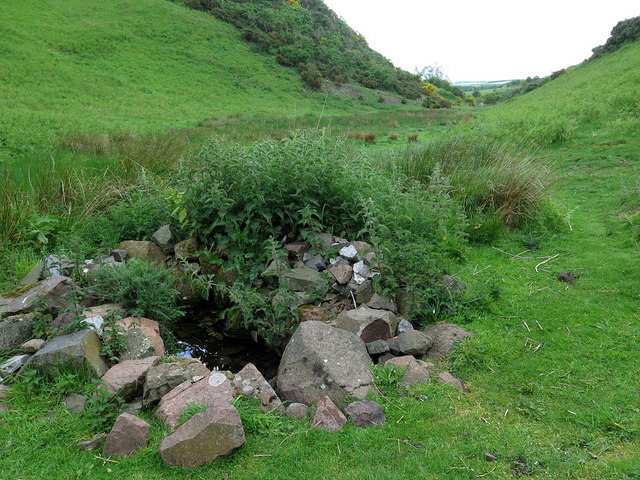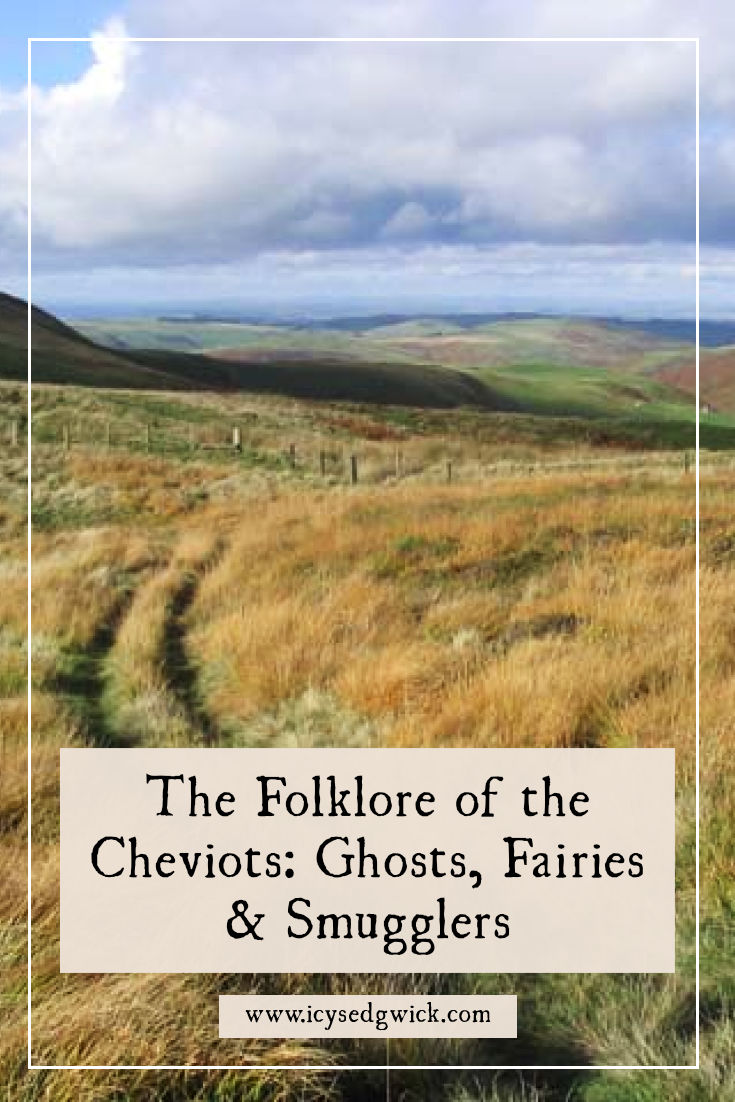There’s something both primal and ancient about mountains. Beautiful and remote, they can provide a harsh and unforgiving environment for those who venture into their territory. Sometimes linked with sleeping giants, mountains are also a reminder of the Earth’s formation, with rock contorted into fantastic shapes by immense geological pressures.
We’re heading into Folklore of Mountains and Hills month, so it’s worth pointing out I already have articles on the Grey Man of Ben Macdui and the Simonside duergar. I also have bonus episodes about the Brocken, home of the Walpurgisnacht revels, and the Hexenkopf in Pennsylvania, available to Patreon supporters.
But I thought I’d start with the Cheviot Hills that run from Northumberland and across into the Scottish Borders. The highest of the hills is the Cheviot, which stands at 815 m. The Hen Hole lies to the north-west side of the Cheviot, which you might remember from dancing fairies article. This is a region that has seen bloodshed through battles in 1388, 1402, and 1464. It’s also an ancient and mostly untouched landscape, so it’s hardly surprising you’d find legends of fairies and other supernatural folk up here.
Celtic Gods of the Cheviots
We also know which deities the Celtic inhabitants of the area favoured. Remember, this part of the British Isles can also claim Celtic ancestry due to its proximity to Scotland. As it is, Scotland only relinquished it’s claim to Northumberland in 1237 (Jackson 2021: 15). As William Young points out, thanks to the presence of nearby Hadrian’s Wall, the Romans wrote about the native gods they encountered (2023). As an example, Young explains that the Roman soldiers believed either Silvanus Cocidius or Mars Cocidius ruled the moors and forests of the Cheviots (2023).

I’ve covered both Mars and Silvanus before as Roman deities, but here they’re linked with the native Celtic Cocidius. Young suggests that Cocidius may have had a warlike aspect, which explains his connection to Mars (2023). Yet the wilderness associated with Silvanus may have also played a role in Cocidius’ story. I highly recommend Young’s guide to the Cheviots for the exceptional photographs and detailed discussion of the history and available walks.
I can’t help thinking Mars Cocidius would be either fascinated or bemused by the nearby location of the military firing range at Otterburn!
The Cheviot Smuggler
One legend involves the shenanigans of smuggling. Smugglers carried two main products across the Cheviot Hills: whisky and salt. As it is, there’s apparently a path among the hills near Newton Tors called ‘Salters Path’ in reference to this lost history (Reynolds 1990: 14).
Whisky is the subject of this particular legend. MA Richardson relates the tale in his The Borderer’s table book (1846). Towards the end of the 18th century, there were few excise officers along the border, so Scottish whisky often found its way into England. One such smuggler was Donald McDonald, who hailed from the Highlands. He finally decided to forego the exciting life of a smuggler to distil his own whisky. He’d done so in the hills of Inverness, so he assumed he could replicate the process in the Cheviots.

He finally chose a spot for this illicit enterprise and before long, had his distillery up and running. His product became so beloved in the neighbourhood that neighbours dropped by at all hours to sample his wares. Donald didn’t want to risk earning their ill will, but he also knew they were drinking his profits.
One afternoon, a stranger arrived on horseback. Donald easily discerned that the man would expect to sample his whiskey, and laid out a spread for him. There was a problem. The man was actually an excise officer, and he told Donald he needed to arrest him. An argument ensued, and Donald got the excise officer to admit no one had seen him come in. As Donald pointed out, if that was the case, no one would see him leave either. He drew a pistol and sword and levelled them at the excise officer.
The officer, unsure how to handle the situation, helped himself to more bread, cheese, and whiskey. In fact, he enjoyed so much whisky that he passed out on Donald’s bed.
Donald, who didn’t actually want to kill the officer, pressed the officer’s horse into action. While the excise officer slept, he moved his distillery to a safe location. By the time the officer awoke the next day, he found Donald, the distillery, and his horse gone. He finally managed to find the path and made his way back to civilisation. He mustered a force to accompany him to arrest Donald, but when he returned to the spot, everything was gone. Only his horse remained, and the barrel of whiskey Donald had left for the arresting company.
As far as we know, no one ever did manage to arrest Donald McDonald…
The Pin Well and the King’s Chair
It wouldn’t be Northumbrian folklore without a mention of either kings of old, or fairies. The small town of Wooler lies at the base of the Cheviots and has both! A footpath from the town heads up the hill towards the Pin Well and the King’s Chair.
The King’s Chair is a large rock that juts out of the hill above the well. It apparently takes its name from a king who sat here while his army fought a battle below (Francis 1874: 77). Naturally, some say it’s Arthur, but there’s no evidence to suggest that to be the case. As it is, no one knows the name of the king, the time of the battle, or even who fought. It’s a good example of a legend becoming attached to a natural feature, almost to explain its shape.
The Pin Well, or Fairy’s Well, is formed of large granite stones, that create a rough basin. You can see a collection of crooked pins at the bottom, and according to Francis Francis, the pins are “in every state of preservation” (1874: 77). As the belief goes, you could bend a pin and drop it into the well while making your wish. The pin acted like an offering to the fairies, who would hopefully grant said wish. Francis suggests that young women hoping for a partner most often made use of the practice.

Louise E Tolson adds that locals did this on May Day every year (no date). This is actually something you find with a range of wells, often associated with healing. People would leave pins as an offering, as they did at the Loch Sheanta spring on Skye. At the well of St John at Mount Grace Priory in North Yorkshire, people would stick a pin through an ivy leaf before floating it on the water to make their wish. Leaves that floated meant the wish would come true, leaves that sank meant the wish would go ungranted (Gary 2022: 60).
Haunted Moorland in the Hills
I thought we’d close with ghosts, since we’ve already had a local legend, fairies, and a potential link with King Arthur. Why not the supernatural in a more classical sense?
The A68 crosses the Cheviots into Scotland, and the road takes us through the Carter Bar pass. The name refers to a long-gone toll gate, with the area originally known as the Redeswire.

In the days when the Marches stretched along both sides of the border, providing the so-called Debatable Lands of the Border Reivers, Carter Bar played an important role. The March wardens held truce days here, where they conducted business related to the border, such as justice or compensation for raids. In 1575, the wardens met for a typical truce day on 7 June. For whatever reason, the meeting descended into violence. Scottish reinforcements arrived, sending the English south in defeat. The event became known as the Raid of the Redeswire.
Yet one of the Englishmen, a man named Thomas Ellesden, apparently never left the site (Matthews 2009: 121). Beheaded by a Scottish claymore, his ghost seemingly still wanders the moors at the site.
The Friendly Ghost
The Catcleugh Reservoir lies 2.6 miles to the southeast of Carter Bar. Our other Cheviot ghost haunts the area. In life, Percy Reed was a 15th-century landowner at Troughend. Known for his honesty and fighting prowess, he became one of the border wardens. During his tenure, he saw several reivers from the notorious Crosier clan meet their end on the gallows. The Crosiers vowed vengeance, and enlisted Reed’s neighbours, the Halls, to help them.

One day, the Halls invited Reed to go hunting with them. Having no reason to suspect them of treachery, Reed agreed. He walked into the Crosier ambush, and the reivers hacked Reed to pieces. The locals shunned the Halls for their part in the affair.
People started seeing Reed’s ghost on the moor near his home, and in the valley where we now find the reservoir. In some sightings, he wears a green hunting coat and sounds his horn as if he still hunts in the area. In others, he wears the clothes of a 15th-century gentleman. By all accounts, he’s considered friendly and approachable. In the past, he’s even helped lost travellers find the road again (Matthews 2009: 123). Given what happened to him, it’s somewhat touching that he retained his good humour in death.
The Folklore of the Cheviots
In many ways, the folklore of the Cheviots reflects the nature of the place. The legend of Donald McDonald speaks of ingenuity, wit, and cunning – all qualities that certainly serve you well in such a remote landscape. Indeed, it’s the ideal location in which to find an ancient god of the wilderness.
Meanwhile, the King’s Chair speaks of battles of a bygone age, reflecting the bloodshed and violence of the later fighting of the Reivers. The Pin Well reminds us of the presence of the Fair Folk in these primal landscapes. If we believe the legends, we’ll find them making music at Hen Hole.
I do recommend visiting the Cheviots, but remember the basics. Know how to read a map in case your technology fails. Check the weather before you go. Wear sturdy boots, the right clothing, and let someone know where you’re going.
And maybe keep an offering for the fairies with you. Just in case…
References
Francis Francis (1874), By Lake and River, Frankfurt: Verlag.
Gary, Gemma (2022), Wisht Waters: The Cult & Magic of Water, London: Troy Books.
Jackson, Dan (2021), The Northumbrians: North-East England and Its People, A New History, revised edition, London: C Hurst & Co (affiliate link).
Matthews, Rupert (2009), Mysterious Northumberland, Derby: Breedon Books (affiliate link).
Reynolds, Hazel (1990), Rogues and Reivers of the North Country, Morpeth: Coquet Editions.
Richardson, M.A. (1846), The Borderer’s Table Book; or, Gatherings of the Local History and Romance of the English and Scottish Border, volume 5, Newcastle upon Tyne: M.A. Richardson.
Tolson, Louise E (no date), ‘5 Folklore Sites in Northumberland you can Visit for Free’, Louise E Tolson: Artist, https://tolsonpenandink.co.uk/blogs/blog/5-folklore-sites-in-northumberland-you-can-visit-for-free.
Young, William (2023), ‘The Savage Spirits of the Cheviots – The Duergar of Coquetdale, and the Brown Man of the Moors’, Inter-Celtic, https://inter-celtic.com/the-savage-spirits-of-the-cheviots/.
Nutty about folklore and want more?
Add your email below and get these posts in your inbox every week.
You'll also get my 5-step guide to protecting your home using folklore!







Have your say!